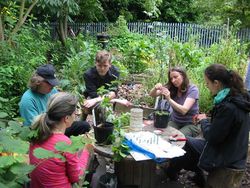 I think I could happily say that all my favourite meals have been picnics. Maybe it's because I was born at midsummer that the outside has always felt the most natural place to eat. I love that lack of formality, lunching and breakfasting in unexpected and temporary places, immersed in heather, surrounded by dragonflies, on the top of a cliff. When I was a child in the city it was a big treat to go into the countryside and sit in a field or in the woods with the picnic basket (with its lily of the valley china) and eat summer specials like cold chicken and sausages, strawberries and slices of melon, and a bottle of wine cooling in the stream or rockpool.
I think I could happily say that all my favourite meals have been picnics. Maybe it's because I was born at midsummer that the outside has always felt the most natural place to eat. I love that lack of formality, lunching and breakfasting in unexpected and temporary places, immersed in heather, surrounded by dragonflies, on the top of a cliff. When I was a child in the city it was a big treat to go into the countryside and sit in a field or in the woods with the picnic basket (with its lily of the valley china) and eat summer specials like cold chicken and sausages, strawberries and slices of melon, and a bottle of wine cooling in the stream or rockpool.Even now, when I no longer go on holiday, or it rains too many days in a row, I like to go down to the seashore and sit among the dunes. I don't have a basket or eat classic al fresco fare anymore, but I do have the other essentials, a rug and a thermos and a picnic attitude. Which is: enjoy everything while you can! Picnics can be solitary - sitting eating a sandwich or an apple under a tree, along a trackway, up a mountain. On the train, en route somewhere. But there is nothing like having a picnic with a gang of your fellows.
 One of the best ways to show that downshifting is not always a bad or difficult thing is to say: you can share more picnics! More time to enjoy the outside, less fuss indoors. Imagine no more awkward restaurant moments, no snobbery, no rules, no white tablecloths. Just simple fare, fresh bread and home-made dishes, under an open sky, or round a camp fire! And it's also a great way to explain resilience as you try to avoid the rain and celebrate meeting up come what may.
One of the best ways to show that downshifting is not always a bad or difficult thing is to say: you can share more picnics! More time to enjoy the outside, less fuss indoors. Imagine no more awkward restaurant moments, no snobbery, no rules, no white tablecloths. Just simple fare, fresh bread and home-made dishes, under an open sky, or round a camp fire! And it's also a great way to explain resilience as you try to avoid the rain and celebrate meeting up come what may. In Transition where bringing-to-share in recycled plastic boxes and tin plates is a default, practically all our summer meals can be eaten outdoors. Our first Transition Norwich Midsummer Party was held at the Ranger's House (in the pouring rain), accompanied by reskilling sessions, give-and-take and a peak oil info tent. Our Sustainable Bungay annual summer picnics are held with a rowdy and very unstructured rounders game under the lime trees on the Old Grammar School field (though this year's will take place in Cathy's orchard meadow with a more restrained game of boules). Elderflower champagne and allotment pickles are the star turns.
In Transition where bringing-to-share in recycled plastic boxes and tin plates is a default, practically all our summer meals can be eaten outdoors. Our first Transition Norwich Midsummer Party was held at the Ranger's House (in the pouring rain), accompanied by reskilling sessions, give-and-take and a peak oil info tent. Our Sustainable Bungay annual summer picnics are held with a rowdy and very unstructured rounders game under the lime trees on the Old Grammar School field (though this year's will take place in Cathy's orchard meadow with a more restrained game of boules). Elderflower champagne and allotment pickles are the star turns.Our Dark Mountain Norwich crew held a garden lunch - polenta bake, lots of new potatoes and broad beans -and then went down to the sea in Kevin's wonderful campervan (soon to be turned into a mini film and storytelling theatre), where we had tea and wine and cake at the end of the day. Here the Low Carbon Cookbook crew are tucking into a tea under the London plane after a busy Bungay Beehive Day, including Great British Bean hummus made by Sophie, freegan bread (from Norwich Foodcycle), plus Erik's wonderful cous cous and garden leaf salad. Raspberry wine, plum jam and left over cake kindly supplied by Nick from Sustainable Bungay.
 Meanwhile here is a staple of all our picnics: the tortilla, also known as frittata, which is the Italian version. Mark's is made with tomatoes, now finally in season (hurrah!) and home-grown herbs. We used to get our eggs from Sarah's stall down the road, but alas, the man who used to keep chickens on the Southwold allotments had to go to hospital (he is 86) and let them go. So these are made with eggs from Maple Farm. They are organic and very free range, but it's still a commercial operation, which means the hens are "replaced" every year. Transition food dilemma No. 146 . . .
Meanwhile here is a staple of all our picnics: the tortilla, also known as frittata, which is the Italian version. Mark's is made with tomatoes, now finally in season (hurrah!) and home-grown herbs. We used to get our eggs from Sarah's stall down the road, but alas, the man who used to keep chickens on the Southwold allotments had to go to hospital (he is 86) and let them go. So these are made with eggs from Maple Farm. They are organic and very free range, but it's still a commercial operation, which means the hens are "replaced" every year. Transition food dilemma No. 146 . . . Serves 4
Serves 42 medium sized potatoes
1 onion
6-8 eggs
1 or 2 tomatoes (optional)
olive oil
fresh or dried thyme, oregano, rosemary or basil (or combination)
sea salt
pepper
Slice potatoes into rounds 1/2cm thick. Boil until just cooked. Drain.
Slice onions into rounds. Gently fry until transparent.
Add potatoes to pan. (At this point you can add the tablespoon of bottled tomatoes)
Beat eggs very lightly with a fork, adding herbs, salt and pepper and keeping the white and yolk slightly separate.
Fold egg mixture evenly into the potatoes and onions. Fry gently for a few minutes.
Place frying pan under medium grill (you can put sliced tomato rounds on top of the tortilla before it sets) to lightly brown.
The tortilla is cooked when it comes easily away from the pan and there is no liquid. You can test it with a knife. I sometimes need to place it back on the stove for a minute or two after the grill.
Turn out on wire rack. Eat hot or cold with fresh salad and bread. It often tastes even more delicious cold the next day (MW)
Kevin's campervan by Southwold marshes; Sustainable Bungay's Summer Picnic, old grammar school playing field, 2011; Diana and Mark, Dark Mountain Norwich picnic 2012; Low Carbon Cookbook picnic, July 2012, Bungay; Charlotte's birthday tortilla June 2011









































 Dark Mountain: Issue 20 - ABYSS is available
Dark Mountain: Issue 20 - ABYSS is available 